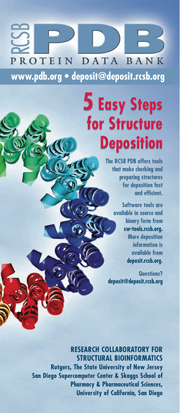
for Structural Bioinformatics Protein Data Bank
Summer 2009
Number 42
|
5 Easy Steps for Structure Deposition
1. Check the sequence, which should contain all residues used in the experiment, including expression tags and residues missing due to disorder. Use BLAST1 to determine the appropriate sequence database references for the proteins or nucleic acids present in the file. Any sequence mismatches should correspond to mutation, variant or expression tags in the submitted sequence.
Improve the Quality of Your Depositions with SFCHECK SFCHECK generates reports containing R-factors, density correlation, Luzzati plots, Wilson plots, temperature factors, local error estimation by residues, and more. It is a part of the Validation Server and ADIT tools, and is used by the RCSB PDB during the annotation process. SFCHECK is also part of SF-Tool, a streamlined, web-based tool for validating crystallographic experimental data. In addition to validating model coordinates against structure factor data with SFCHECK, SF-Tool can:
For more information, please see deposit.pdb.org. How does an HPUB structure get released? The wwPDB receives publication dates and citation information directly from a few journals. For most articles, however, the wwPDB searches PubMed and scans the literature for publication information. Citations emailed to deposit@wwpdb.org are also greatly appreciated. There is a one-year limit on the length of a hold period, including those for HPUBs. If the citation for a structure is not published within the one-year period, depositors will be given the option to either release or withdraw the deposition. In the second quarter of 2009, 2079 experimentally-determined structures were deposited to the PDB archive. The entries were processed by wwPDB teams at the RCSB PDB, PDBe, and PDBj. Of the structures deposited, 72.7% were deposited with a release status of HPUB; 24.6% were released as soon as annotation of the entry was complete; and 2.7% were held until a particular date. 91.8% of these entries were determined by X-ray crystallographic methods; 7.3% were determined by NMR methods. 1874 structures were released in the PDB during the same period. 1 S.F. Altschul, W. Gish, W. Miller, E.W. Myers, & D.J. Lipman (1990) Basic local alignment search tool. J. Mol. Biol. 215:403-410. 2 A.A. Vaguine, J. Richelle, S.J. Wodak (1999) SFCHECK: a unified set of procedures for evaluating the quality of macromolecular structure-factor data and their agreement with the atomic model. Acta Crystallogr. D55:191-205. |
E-mail: info@rcsb.org • Web: www.pdb.org • FTP: ftp.wwpdb.org
The RCSB PDB is a member of the wwPDB (www.wwpdb.org)
